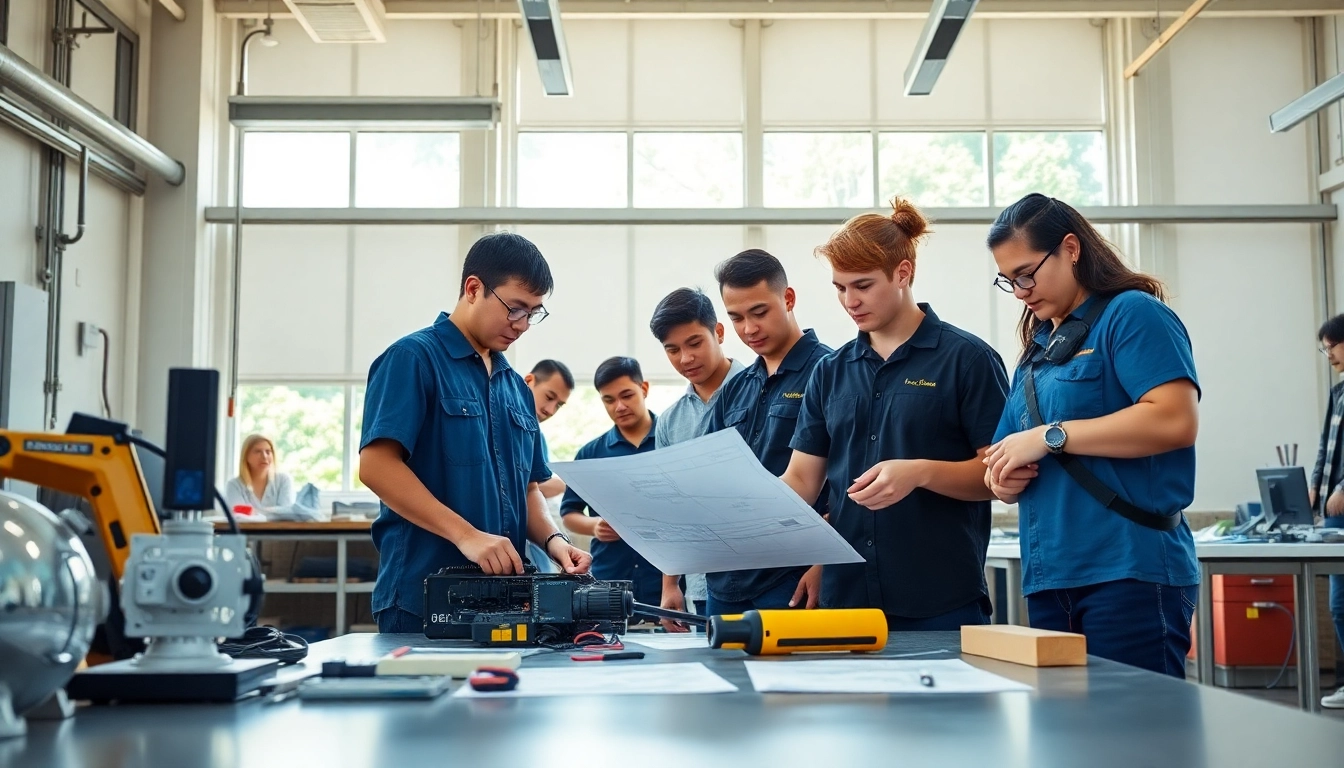Understanding the Benefits of Trade Schools in Hawaii
As the economy evolves, so do the pathways to a successful career. For many individuals considering their future, trade schools in Hawaii offer a viable alternative to traditional college education. These institutions specialize in equipping students with the practical skills and knowledge necessary for fulfilling careers in various trades. Here, we explore the many benefits of enrolling in a trade school and how this educational route can lead to a brighter future.
Career Opportunities After Graduation
One of the most significant advantages of attending trade schools in Hawaii is the abundance of career opportunities that await graduates. The skilled trades sector is experiencing robust growth, with a demand for qualified professionals in fields like plumbing, electrical work, construction, and automotive technology. For example, the state often faces a shortage of skilled workers, leading to higher salaries and job security for those entering the workforce with the proper training.
Moreover, trade school programs typically focus on industry-relevant skills, offering certifications that hold value in the job market. This hands-on training equips graduates with the expertise employers seek, making them immediate assets to potential employers. Many graduates step right into well-paying jobs shortly after completing their programs, often without the student debt that’s typical for traditional four-year universities.
Cost-Effectiveness Compared to Traditional Colleges
The financial implications of education cannot be overlooked, especially when considering the rising cost of higher education. Trade schools in Hawaii often present a more cost-effective option compared to traditional colleges. While the average cost of a four-year degree can exceed $100,000, trade schools typically charge significantly lower tuition. Students can complete their programs in a fraction of the time—often in one to two years—allowing them to enter the workforce quickly.
Additionally, many trade programs include hands-on training and apprenticeships, which can further reduce educational expenses. Students may even earn wages while learning, providing a financial buffer during their education. When students view the overall cost of education through the lens of return on investment, the advantages of trade schools become clear.
The Importance of Hands-On Training
One of the core philosophies of trade schools in Hawaii is the emphasis on hands-on training. Unlike traditional academic settings where theoretical knowledge is paramount, trade schools prioritize practical skills essential for day-to-day operations in respective fields. This focus hands students the tools they need for real-world success, building confidence through direct application of learned skills.
For instance, students in automotive technology programs will spend ample time in workshops repairing vehicles, while those in culinary arts will be constantly engaged in food preparation under the guidance of professional chefs. This experiential learning not only solidifies knowledge but also enhances employability, as graduates can demonstrate proficiency in their trade right out of school.
Exploring Various Trade Programs Available
With numerous options available, prospective students can choose a trade that aligns with their interests and career aspirations. Whether you are drawn to the arts, sciences, or practical vocations, trade schools in Hawaii offer diverse programs to cater to a variety of passions and skills.
Popular Fields of Study in Trade Schools in Hawaii
Among the most popular fields of study in Hawaii’s trade schools are construction technology, culinary arts, automotive repair, healthcare services, electrical technology, information technology, and hospitality management. Each field presents unique opportunities and challenges, allowing students to align their education with their career goals.
For example, the construction industry is booming, providing numerous opportunities for skilled workers. Similarly, healthcare occupations are constantly in demand, particularly in areas like nursing, surgical technology, and medical assisting. This diversity in fields means that students can find a program that not only interests them but also promises a stable career path after graduation.
Program Length and Schedule Flexibility
Another significant advantage of trade schools in Hawaii is the flexibility they often provide in terms of scheduling. Many programs offer part-time studies, evening classes, and online coursework to accommodate working students or those with other commitments. This flexibility enhances accessibility for individuals who may not be able to dedicate themselves to a full-time program.
Program lengths can vary, typically ranging from a few months to two years, depending on the field of study and the depth of the curriculum. Because of this shorter duration, students are not only able to enter the workforce sooner, but they can also pivot quickly if their interests change. This adaptability is crucial in a rapidly changing job market.
Requirements for Enrollment in Trade Programs
Most trade schools have a relatively straightforward enrollment process. Requirements often include a high school diploma or equivalent, though some programs may be more lenient regarding this aspect. Other prerequisites may involve placement tests to ensure students meet baseline competencies for specific courses.
Prospective students should also consider any additional certifications or licenses they may need to pursue their desired trade. For instance, electricians often require state licensure, which entails passing certain exams. Understanding these requirements in advance can help students prepare adequately for a smooth transition into their selected programs.
Financial Aid and Scholarships for Trade Schools in Hawaii
Financing your education should not deter you from pursuing your passion. Trade schools in Hawaii offer various financial aid options, making them accessible to students from all backgrounds.
Understanding Tuition Costs and Fees
Before enrolling, students should familiarize themselves with the overall costs associated with trade schools in Hawaii, including tuition fees, books, supplies, and potential lab fees. Understanding these costs upfront can allow for better financial planning and help students compare various programs effectively.
Types of Financial Aid Available
Financial aid options for trade schools are diverse and include federal grants, student loans, and state scholarships. Federal Pell Grants, for instance, provide assistance based on financial need, while many trade schools also offer institution-specific scholarships that can help alleviate some costs. Applying for financial aid can also open up eligibility for work-study jobs that allow students to earn money while studying.
Resources for Finding Scholarships
Numerous resources exist for students seeking scholarships. Websites like Fastweb and Scholarship.com compile scholarships based on various criteria, allowing students to target their search effectively. Additionally, many local organizations, businesses, and community foundations offer merit and need-based scholarship opportunities specifically for individuals attending trade schools. Networking within your community and seeking advice from school counselors can also uncover hidden scholarship opportunities.
Preparing for a Successful Experience in Trade Schools
Preparation is key to maximizing the trade school experience. Students who enter their programs fully prepared tend to perform better academically and build connections that last throughout their careers.
Essential Skills for Trade School Students
Beyond the specific technical skills pertinent to each trade, certain soft skills remain crucial for success in trade schools. These skills include effective communication, problem-solving, and critical thinking. Students should also cultivate time management skills and the ability to work both independently and in teams.
Many trade school programs incorporate teamwork into their curricula, further emphasizing the need for interpersonal skills. For instance, work environments in construction projects often require collaboration among various trades to complete a job successfully. In this light, cultivating strong soft skills can significantly boost a student’s prospects after graduation.
Choosing the Right Program for Your Career Goals
Deciding on a trade program can feel overwhelming, given the wide range of available choices. Prospective students can benefit from conducting thorough research on each field’s employment outlook, salary potential, and required qualifications. Career fairs and information sessions also provide valuable insights into the realities of various trades, allowing students to make informed decisions.
Networking and Building Industry Connections
Lastly, networking plays a fundamental role in career advancement. Students should take advantage of opportunities to connect with instructors, industry professionals, and fellow classmates. Engaging in discussions, participating in workshops, and attending job fairs can all contribute to a robust professional network. These connections can open doors to job opportunities, mentorship, and industry insights that are invaluable throughout one’s career.
The Future of Trade Education in Hawaii
As the demand for skilled tradespeople continues to grow, the future of trade education is looking promising. Innovations in training, curriculum updates, and a focus on community involvement indicate a bright path ahead for trade schools in Hawaii.
Trends in Trade Education and Job Market
Recent trends show an increasing acceptance of trade education as a legitimate and beneficial pathway to a successful career. More high schools are offering vocational training options, effectively preparing students to enter trade schools directly after graduation. Employers are also recognizing the value of skilled trades, often offering competitive salaries and benefits to attract qualified workers.
Advancements in Training Technology
Technological advancements are also shaping trade education. Integrating virtual reality and simulation technology into training programs allows students to gain experience in a controlled environment before entering the field. For example, aspiring electricians can practice wiring techniques in a simulated setting, reducing the risk associated with real-world training.
Community Impact of Trade Schools in Hawaii
Trade schools play a vital role in the economic landscape of Hawaii. By providing students with the skills needed for lucrative and essential careers, they contribute to workforce development and local economies. Additionally, trade schools often hold workshops and community events that advocate for skilled trades, raising awareness of their importance within the community.
As trade education continues to evolve, it brings with it an array of opportunities for students and communities alike. By investing in trade education, Hawaii not only fosters individual career growth but also nurtures a stronger, more skilled workforce, ensuring continued economic development and community well-being.



